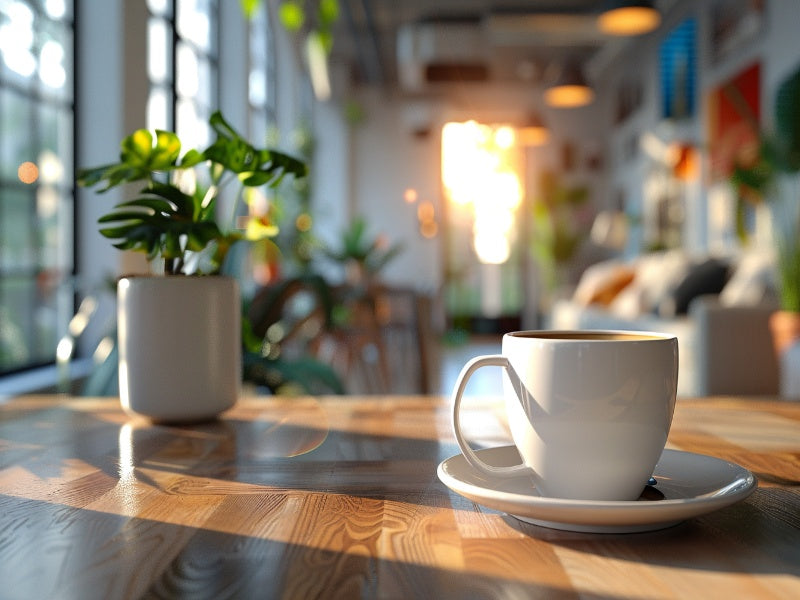A coffee table is a common piece of furniture found in living rooms, usually placed in front of a sofa or seating area. It is a low table, designed to hold beverages, snacks, books, and other items while lounging in the living room. Coffee tables come in various styles, designs, and sizes, but what is the standard measurement for a coffee table?
According to the American Society of Furniture Designers, there are three main measurements to consider when purchasing a coffee table: height, width, and length. The standard height for a coffee table is typically between 16-18 inches, but this can vary depending on different factors.
Factors such as style and design, functionality, and proportion to other furniture can affect the height of a coffee table. For example, a modern and sleek coffee table may have a lower height than a traditional and bulky one. A coffee table with storage options may also have a taller height to accommodate for the added space inside.
Some common types of coffee tables and their heights include:
- Standard Coffee Table (16-18 inches): The most common and traditional height for a coffee table, suitable for most sofas and seating.
- Low Coffee Table (12-16 inches): A lower height option, often used in a modern and minimalistic setting.
- High Coffee Table (18-24 inches): Taller than the standard height, these tables are often used as a statement piece in a room.
- Adjustable Coffee Table (varies): These tables have a height that can be adjusted according to personal preference or function.
When choosing the right height for your coffee table, consider the height of your sofa, the functionality of the table, and the proportion to other furniture in the room. Ultimately, personal preference and comfort should also play a role in your decision. With this information in mind, you can confidently choose the perfect height for your coffee table.
What Is a Coffee Table?
A coffee table is a low table designed to be placed in a sitting area for convenient support of beverages, remote controls, magazines, books, and other small items. Typically positioned in front of a sofa or seating arrangement, a coffee table has a standard height ranging from 16 to 18 inches, although modern designs may vary. Some coffee tables also offer storage options, such as drawers or shelves, to help keep the living room tidy. They come in various shapes, including rectangular, round, and oval, to complement different room layouts. When selecting a coffee table, it is important to ensure it is proportionate to the seating and allows for easy movement in the living area.
What Are the Standard Measurements for a Coffee Table?

When it comes to furniture, having the right measurements is crucial for achieving a functional and visually pleasing space. In this section, we will focus on one particular piece of furniture - the coffee table - and its standard measurements. From height to width to length, we will discuss the typical dimensions of a coffee table and how they can vary depending on your personal preferences and needs. So, let's dive into the world of coffee table measurements and discover the perfect size for your living room.
1. Height
When determining the height of your coffee table, follow these steps:
- Consider the Height of Your Sofa: Choose a table that is the same height or slightly lower than your sofa seat.
- Think about the Functionality of the Table: For a table used mainly for decorative purposes, a lower height can work, while a higher table suits serving snacks or meals.
- Keep Proportion in Mind: Ensure the table's height complements the surrounding furniture and room dimensions.
- Consider Your Personal Preference: Ultimately, opt for a height that aligns with your comfort and aesthetic preferences.
The history of coffee tables dates back to the late Victorian era when the concept of a low table to hold coffee cups gained popularity. By the 1920s, coffee tables became staple furniture in living rooms, evolving in height and design to suit changing needs and trends.
2. Width
- Measure the space: Before choosing a coffee table, determine the width of the available space in your living room to ensure the table fits comfortably without obstructing the walking area.
- Consider the seating area: The width of the coffee table should be proportionate to the width of the seating area. A general rule is that the table's width should be around two-thirds to three-quarters the length of your sofa.
- Allow for movement: Leave at least 12-18 inches between the coffee table and the surrounding seating to allow for easy movement and access to the table.
- Match the style: Make sure the width of the coffee table complements the style and scale of the room and other furniture pieces for a cohesive look.
3. Length
- To determine the appropriate length for your coffee table, measure the available space in your living room or seating area.
- Consider the length of your sofa or seating arrangement to ensure the coffee table complements the setup.
- Think about the functionality you require from the table. If you need ample space for decor, entertainment, or storage, opt for a longer coffee table.
- Keep proportion in mind when selecting the length. For larger seating areas, a longer coffee table may be more proportional, while smaller spaces might benefit from a shorter table.
Pro-tip: When choosing the length of your coffee table, make sure there is enough room to move around it comfortably, and leave sufficient space between the table and other furniture for ease of movement and visual balance.
How Tall Is a Coffee Table Usually?
- Coffee tables typically range from 16 to 18 inches in height, which is the standard measurement.
- To ensure the coffee table's height complements your seating, maintain a 1-2 inch differential between the seat and the table's top.
- Consider the table's primary function. For serving purposes, a lower height may be suitable, while a higher table could work better for displaying decorative items.
- Take into account the surrounding furniture. If the sofa or chairs are lower or higher than usual, adjust the coffee table's height to maintain visual harmony in the living space.
When selecting a coffee table, aim for a height that aligns with your specific needs and preferences. Additionally, consider the design, material, and functionality to find the perfect fit for your space.
What Factors Can Affect the Height of a Coffee Table?

When it comes to furniture, there are many factors to consider, and the height of a coffee table is no exception. The height of a coffee table can vary greatly depending on various elements such as style, functionality, and proportion to other furniture in a room. In this section, we will delve into these factors and how they can impact the height of a coffee table, providing you with a better understanding of this essential piece of furniture.
1. Style and Design
- Take into consideration the style and design of your living room when deciding on the height of your coffee table.
- For a modern and sleek living room, a lower coffee table would be a suitable choice to complement the contemporary design.
- If your living room features traditional or vintage furniture, a standard height coffee table can enhance the classic aesthetic.
- When choosing an adjustable coffee table, make sure that its height variations fit in with the style and design elements of the room.
Fun fact: The style and design of a coffee table can greatly impact the overall ambiance of a living space, making it a crucial factor to consider when selecting the perfect height.
2. Functionality
- Consider the functionality of the table in your living space to determine its height.
- Assess how you intend to use the coffee table - for serving refreshments, displaying decor, or as a footrest.
- Factor in storage needs; if the table will house items like books or magazines, opt for a height that allows easy access.
- For versatile usage, choose an adjustable coffee table that caters to different functionalities and preferences.
3. Proportion to Other Furniture
- Evaluate the furniture arrangement in the living space to maintain harmony and balance, paying attention to proportion in relation to other furniture pieces.
- Make sure that the height of the coffee table complements the adjacent seating, allowing for easy access to items on the table.
- Consider the heights of other furniture pieces, such as side tables or ottomans, to ensure a cohesive look.
- For a visually appealing setup, the coffee table's height should align with the surrounding furniture, creating a sense of unity.
What Are Some Common Types of Coffee Tables and Their Heights?

When it comes to furnishing our living spaces, coffee tables are an essential piece that often goes overlooked. However, choosing the right height for your coffee table can make a significant difference in the functionality and aesthetics of your room. In this section, we'll explore the various types of coffee tables commonly used in homes and their corresponding heights. From the standard coffee table to the low, high, and even adjustable coffee table, we'll discuss each type and its unique features. So, let's dive in and find the perfect coffee table height for your space.
1. Standard Coffee Table
- Determine the ideal standard coffee table height by measuring the height of your sofa.
- Standard coffee tables typically range from 16 to 18 inches in height, which complements most standard sofas.
- When considering the functionality of the table, keep in mind that a slightly lower or higher standard coffee table may better suit your decorative preferences.
- Maintain visual balance by ensuring the standard coffee table's height is proportionate to the surrounding furniture.
- When it comes to standard coffee table height, personal preference is important. Choose a height that aligns with your comfort and aesthetic desires.
2. Low Coffee Table
A low coffee table, typically measuring between 12 to 16 inches in height, is the perfect addition to a seating area featuring low-slung sofas or floor cushions. It creates a laid-back and casual atmosphere, perfect for informal gatherings or simply lounging. This type of coffee table is particularly well-suited for contemporary or Japanese-inspired interiors, adding a minimalist and clutter-free aesthetic.
Low coffee tables also help to create an open and spacious feel within a room, making them a great choice for smaller living areas. When choosing a low coffee table, make sure it complements the overall design scheme and allows for easy access to items placed on it. Consider materials such as wood or glass, which will complement the desired style and enhance the visual appeal.
3. High Coffee Table
When considering a high coffee table, follow these steps to ensure the right choice:
- Measure the height of your sofa to determine the appropriate proportional height for the table.
- Consider the intended functionality of the table, whether for decorative purposes or for serving snacks.
- Keep in mind the proportion of the table to other furniture in the room to maintain a cohesive look.
- Factor in your personal preference for the High Coffee Table's height, ensuring it aligns with your comfort and style.
Fact: A high coffee table, typically around 20-22 inches in height, is suitable for spaces with taller seating or for adding a bold visual statement to the room.
Read: Sizing Up How Tall Are Coffee Tables
4. Adjustable Coffee Table
- Consider the versatility: A key benefit of an Adjustable Coffee Table is its ability to serve various purposes, such as dining, working, or storage, by adapting its height to the specific need.
- Assess the mechanism: Evaluate the ease and stability of the adjustment mechanism. Opt for a table with a smooth and secure height adjustment feature, ensuring convenience and safety.
- Visual aesthetics: When choosing an Adjustable Coffee Table, prioritize a design that seamlessly integrates with your existing decor while offering the flexibility of height adjustment.
- Space utilization: Determine the space where the table will be placed and consider how an Adjustable Coffee Table can optimize the area, offering both practicality and style.
How to Choose the Right Height for Your Coffee Table?

1. Consider the Height of Your Sofa
- Take measurements of your sofa's height to determine the perfect height for your coffee table.
- Make sure that the coffee table's height is within 4 inches of the sofa's seat height for comfortable access.
- When selecting a coffee table height, consider both its visual appeal and functionality in relation to the sofa.
- If you have a lower sofa, choose a shorter coffee table to maintain proportion and easy use.
- On the other hand, pair a taller coffee table with a higher sofa to create a cohesive and functional surface.
2. Think about the Functionality of the Table
When considering the functionality of the table, it's important to evaluate how it will be utilized in your living space. If you often have guests over, consider a coffee table with extra storage for items like magazines or coasters. For households with children or a more relaxed atmosphere, a round or oval-shaped table may be a better choice to avoid sharp edges. If the table will primarily be used for decorative purposes, opt for a design with a larger surface area. In addition, for spaces that serve multiple functions, consider adjustable coffee tables that can be converted into a dining surface or workspace. Ultimately, the functionality of the table should align with your lifestyle and requirements, ensuring it serves a practical purpose in your home.
3. Keep Proportion in Mind
Consider the height of your sofa to ensure the coffee table complements it. Think about the functionality of the table and how it supports your activities, such as dining or working. Keep proportion in mind by ensuring the table's height aligns with the surrounding furniture to create a harmonious visual balance. Consider your personal preference regarding the table's height, keeping in mind both aesthetics and practicality.
When selecting the height of a coffee table, it is important to keep proportion in mind to create a balanced and visually appealing living space.
4. Consider Your Personal Preference
When deciding on the height of your coffee table, it's important to take into account your personal preference. This preference may be influenced by your seating arrangement, the intended use of the table, and your individual aesthetic.
Some individuals may prefer a higher coffee table for convenience, while others may choose a lower height for a more relaxed atmosphere. A lower coffee table can create a cozy, informal vibe and encourage a relaxed seating posture. On the other hand, a higher table may be more practical for serving and accessing items.
Ultimately, considering your personal preference ensures that your coffee table complements your lifestyle and enhances the comfort and functionality of your living space.
Pro-tip: If you frequently have guests over, consider opting for a slightly lower coffee table to create a cozy and inviting ambiance.


